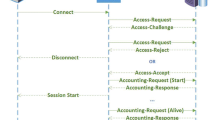Abstract
The user centric nature of mobile devices is an important issue for enhancing the user experience in a mobile wireless communication. A strategy for improving such experience consists of applying a resource management focused in providing both the user and the application valuable information about the network context. The communication quality in wireless systems heavily depends on several factors, and adjusting the application and/or alerting the user about the network conditions is an important service when managing this type of devices. The quality perceived by the user depends on the network context, which can be defined as the events that have significant impact on the wireless communication. The identification of the wireless channel behavior is necessary for obtaining a context description. Due to intrinsic features at the wireless signal propagation it is difficult to measure and assess the fundamental wireless network context, e.g., predicting when low quality signal is being caused by interference or fading effects. This work presents a new method for user centric management on IEEE 802.11b/g: a strategy for communication survival, focused in improving the user experience. Our proposal uses a multi-scale control chart approach, MCEWMA – Moving Centerline Exponential Weighted Moving Average, associated with multi-resolution analysis using a wavelet transform.
















Similar content being viewed by others
References
Aradhye H, Bakshi BR, Strauss RA, Davis JF (2003) Multiscale statistical process control using wavelets—theoretical analysis and properties. AIChE J 49(4):939–958
Bianchi G, Stefano AD, Giaconia C, Scalia L, Terrazzino G, Tinnirello I (2007) Experimental assessment of the backoff behavior of commercial IEEE 802.11b network cards. In: IEEE INFOCOM 2007. 26th IEEE international conference on computer communications. IEEE, Piscataway, pp 1181–1189
Chiann C, Morettin PA (1998) A wavelet analysis for time series. J Nonparametr Stat 10:1–48
Daubechies I (1992) Ten lectures in wavelets. CBMS-NSF regional conferences series in applied mathematics. SIAM, Society for Industrial and Applied Mathematics, Philadelphia
González MC, Hidalgo CA, Barabási A-L (2008) Understanding individual human mobility patterns. Nature 453(7196):779–782
Graziosi F, Santucci F (2002) A general correlation model for shadow fading in mobile radio systems. IEEE Commun Lett 6(3):102–104
Judd G, Akella A, Seshan S, Steenkiste P (2005) Self-management in chaotic wireless deployments. In: MobiCom’05: Proceedings of the 11th annual international conference on mobile computing and networking. ACM, Cologne, pp 185–199
Kim M, Noble B (2001) Mobile network estimation. In: MobiCom’01: proceedings of the 7th annual international conference on mobile computing and networking. Rome, July 2001, pp 298–309
Long X, Sikdar B (2007) Wavelet based detection of shadow fading in wireless networks. In: IEEE global telecommunications conference, 2007. GLOBECOM ’07, Washington, DC, 26–30 November 2007, pp 305–309
Long X, Sikdar B (2008) A real-time algorithm for long range signal strength prediction in wireless networks. In: IEEE wireless communications and networking conference, 2008. WCNC 2008. IEEE, Piscataway, pp 1120–1125
Mallat SG (1999) A wavelet tour of signal processing, 2nd edn. Academic, San Diego
Mhatre VP, Papagiannaki K, Baccelli F (2007) Interference mitigation through power control in high density 802.11 WLANs. In: INFOCOM 2007: 26th IEEE international conference on computer communications. IEEE, Anchorage, pp 535–543
Mhatre V, Papagiannaki K (2006) Using smart triggers for improved user performance in 802.11 wireless networks. In: MobiSys ’06: proceedings of the 4th international conference on mobile systems, applications and services. ACM, New York, pp 246–259
Montgomery D (1996) Introduction to statistical quality control. Wiley, New York
Narasimhan R, Cox DC (1999) Speed estimation in wireless systems using wavelets. IEEE Trans Commun 47:1357–1364
Narasimhan R, Cox DC (2000) Speed estimation in wireless systems using wavelets. IEEE J Sel Areas Commun 18:2220–2227
Oliveira RAR, Loureiro AAF (2008) lmproving user experience and resource management in wireless communications. In: 15th IEEE/IFIP network operations and management symposium. IEEE, Piscataway, pp 1–4
Oliveira RAR, Pereira RR, Loureiro AAF (2007) Adaptive configuration of wpans and wlans communications using multi-scale statistical process control. In: MSWiM ’07: proceedings of the 10th ACM symposium on modeling, analysis, and simulation of wireless and mobile systems. ACM, New York, pp 138–142
Papagiannaki K, Yarvis M, Conner WS (2006) Experimental characterization of home wireless networks and design implications. In: IEEE INFOCOM 2006. 25th IEEE international conference on computer communications. IEEE, Piscataway, pp 1–13
Qiao D, Choi S, Soomro A, Shin KG (2003) Energy-efficient pcf operation of ieee 802.11a wlans via transmit power control. Comput Netw 42(1):39–54
Rappaport T (2002) Wireless communication systems. Prentice Hall PTR, Englewood Cliffs
Tzagkarakis G, Papadopouli M, Tsakalides P (2007) Singular spectrum analysis of traffic workload in a large-scale wireless lan. In: MSWiM ’07: proceedings of the 10th ACM symposium on modeling, analysis, and simulation of wireless and mobile systems. ACM, New York, pp 99–108
Wu H, Tan K, Zhang Y, Zhang Q (2007) Proactive scan: fast handoff with smart triggers for 802.11 wireless LAN. In: IEEE INFOCOM 2007. 26th IEEE international conference on computer communications. IEEE, Piscataway, pp 749–757
Zhu J, Guo X, Roy S, Papagiannaki K (2007) CSMA self-adaptation based on interference differentiation. In: IEEE GLOBECOM ’07 global telecommunications conference, 2007, Washington, DC, 26–30 November 2007
Author information
Authors and Affiliations
Corresponding author
Rights and permissions
About this article
Cite this article
Oliveira, R.R., Loureiro, A.A. & Frery, A.C. A Multi-Scale Statistical Control Process for Mobility and Interference Identification in IEEE 802.11. Mobile Netw Appl 14, 725–743 (2009). https://doi.org/10.1007/s11036-008-0125-6
Published:
Issue Date:
DOI: https://doi.org/10.1007/s11036-008-0125-6




